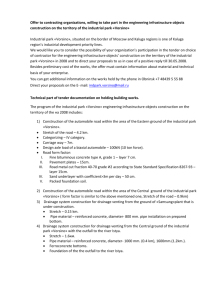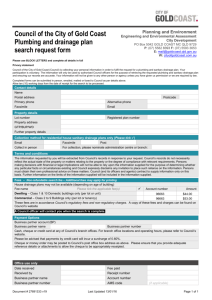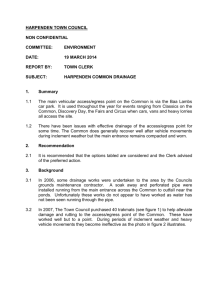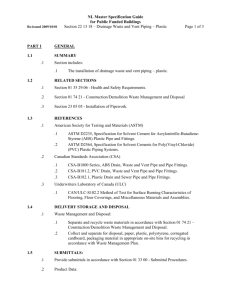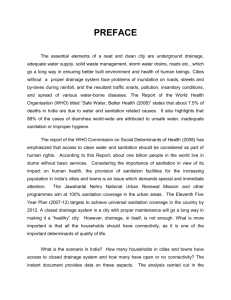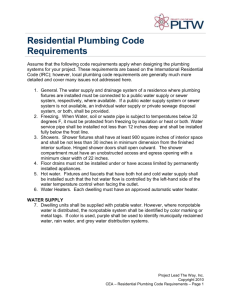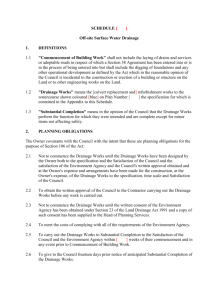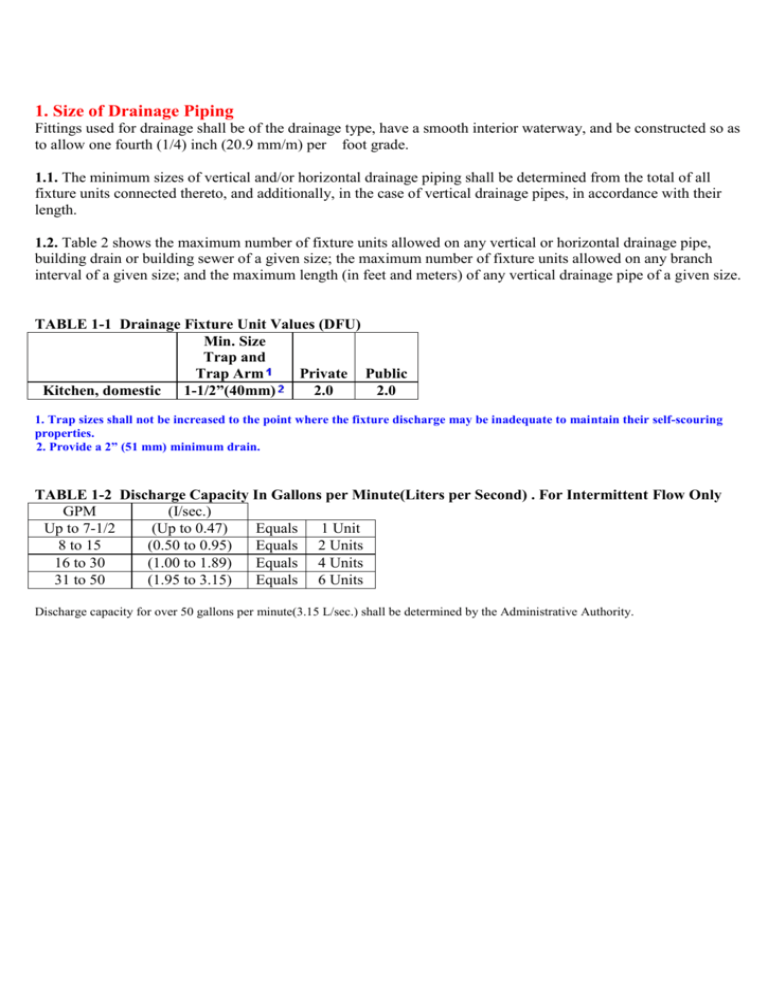
1. Size of Drainage Piping
Fittings used for drainage shall be of the drainage type, have a smooth interior waterway, and be constructed so as
to allow one fourth (1/4) inch (20.9 mm/m) per foot grade.
1.1. The minimum sizes of vertical and/or horizontal drainage piping shall be determined from the total of all
fixture units connected thereto, and additionally, in the case of vertical drainage pipes, in accordance with their
length.
1.2. Table 2 shows the maximum number of fixture units allowed on any vertical or horizontal drainage pipe,
building drain or building sewer of a given size; the maximum number of fixture units allowed on any branch
interval of a given size; and the maximum length (in feet and meters) of any vertical drainage pipe of a given size.
TABLE 1-1 Drainage Fixture Unit Values (DFU)
Min. Size
Trap and
Trap Arm
Private Public
Kitchen, domestic 1-1/2”(40mm)
2.0
2.0
1. Trap sizes shall not be increased to the point where the fixture discharge may be inadequate to maintain their self-scouring
properties.
2. Provide a 2” (51 mm) minimum drain.
TABLE 1-2 Discharge Capacity In Gallons per Minute(Liters per Second) . For Intermittent Flow Only
GPM
(I/sec.)
Up to 7-1/2
(Up to 0.47)
Equals
1 Unit
8 to 15
(0.50 to 0.95)
Equals 2 Units
16 to 30
(1.00 to 1.89)
Equals 4 Units
31 to 50
(1.95 to 3.15)
Equals 6 Units
Discharge capacity for over 50 gallons per minute(3.15 L/sec.) shall be determined by the Administrative Authority.
2. Fixture Connections (Drainage)
Two fixtures set back-to-back, or side-by-side, within the distance allowed between a trap and its vent, may be
served by a single vertical drainage pipe provided that each fixture wastes separately into an approved double
fixture fitting having inlet openings at the same level.
TABLE 2 Maximum Unit Loading and Maximum Length of Drainage and Vent Piping
Size of Pipe, inches
(mm)
Maximum Units
Drainage Piping
Vertical
Horizontal
Maximum Length
Drainage Piping
Vertical, feet
(m)
Horizontal (Unlimited)
Vent Piping
Horizontal and Vertical
Maximum Units
Maximum Lengths, feet
(m)
1-1/4
(32)
1-1/2
(40)
2
(50)
2-1/2
(65)
3
(80)
4
(100)
5
(125)
6
(150)
8
(200)
10
(250)
12
(300)
1
1
2
1
16
8
32
14
48
35
256
216
600
428
1380
720
3600
2640
5600
4680
8400
8200
45
(14)
65
(20)
85
(26)
148
(45)
212
(65)
300
(91)
390
(119)
510
(155)
750
(228)
1
45
(14)
8
60
(18)
24
120
(37)
48
180
(55)
84
212
(65)
256
300
(91)
600
390
(119)
1380
510
(155)
3600
750
(228)
1. Excluding trap arm.
2. Except sinks, urinals and dishwashers.
3. Except six-unit traps or water closets.
4. Only four (4) water closets or six-unit traps allowed on any vertical pipe or stack; and not to exceed three (3) water closets or
six-unit traps on any horizontal branch or drain.
5. Based on one-fourth (1/4) inch per foot (20.9 mm/m) slope. For one-eighth (1/8) inch per foot (10.4 mm/m) slope, multiply
horizontal fixture units by a factor of 0.8.
Note: The diameter of an individual vent shall not be less than one and one-fourth (1-1/4) inches (31.8 mm) nor less than onehalf (1/2) the diameter of the drain to which it is connected. Fixture unit load values for drainage and vent piping shall be
computed from Tables 1-1 and 1-2. Not to exceed one-third (1/3) of the total permitted length of any vent may be installed in a
horizontal position. When vents are increased one (1) pipe size for their entire length, the maximum length limitations specified
in this table do not apply.
3. Changes in Direction of Drainage Flow
3.1. Changes in direction of drainage piping shall be made by the appropriate use of approved fittings and shall be
of the angles presented by a one-sixteenth (1/16) bend, one-eighth (1/8) bend, or one-sixth (1/6) bend, or other
approved fittings of equivalent sweep.
3.2. Horizontal drainage lines, connecting with a vertical stack, shall enter through forty-five (45) degree (0.79
rad) wye branches, sixty (60) degree (1.05 rad) wye branches, combination wye and 1/8 bend branches, sanitary
tee or sanitary tapped tee branches, or other approved fittings of equivalent sweep. No fitting having more than
one (1) inlet at the same level shall be used unless such fitting is constructed so that the discharge from one (1)
inlet cannot readily enter any other inlet. Double sanitary tees may be used when the barrel of the fitting is at least
two (2) pipe sizes larger than the largest inlet, (pipe sizes recognized for this purpose are 2”, 2-1/2”, 3”, 3-1/2”, 4”,
4-1/2”, 5”, 6”, etc.) (50, 65, 80, 90, 100, 115, 125, 150 mm, etc.).
3.3. Horizontal drainage lines connecting with other horizontal drainage lines shall enter through forty-five (45)
degree (0.79 rad) wye branches, combination wye and one-eighth (1/8) bend branches; or other approved fittings
of equivalent sweep. Sixty (60) degree (1.05 rad) branches or offsets may be used only when installed in a true
vertical position.
3.4. Vertical drainage lines connecting with horizontal drainage lines shall enter through forty-five (45) degree
(0.79 rad) wye branches, combination wye and one-eighth (1/8) bend branches; or other approved fittings of
equivalent sweep. Sixty (60) degree (1.05 rad) branches or offsets may be used only when installed in a true
vertical position.
4. Cleanouts
4.1. Each horizontal drainage pipe shall be provided with a cleanout at its upper terminal and each run of piping,
which is more than one hundred (100) feet (30480 mm) in total developed length, shall be provided with a
cleanout for each one hundred (100) feet (30480 mm), or fraction thereof, in length of such piping.
Exceptions:
(1) Cleanouts may be omitted on a horizontal drain line less than five (5) feet (1524 mm) in length unlesuch line
is serving sinks or urinals.
(2) Cleanouts may be omitted on any horizontal drainage pipe installed on a slope of seventy-two (72) degrees
(1.26 rad ) or less from the vertical angle (angle of one-fifth (1/5) bend).
(3) Excepting the building drain and its horizontal branches, a cleanout shall not be required on any pipe or piping
which is above the floor level of the lowest floor of the building.
(4) An approved type of two-way cleanout fitting, installed inside the building wall near the connection between
the building drain and building sewer or installed outside of a building at the lower end of a building drain and
extended to grade, may be substituted for an upper terminal cleanout.
4.2.An additional cleanout shall be provided in a drainage line for each aggregate horizontal change of direction
exceeding one hundred and thirty-five 135) degrees (2.36 rad).
4.3. Each cleanout shall be installed so that it opens to allow cleaning in the direction of flow of the soil or waste
or at right angles thereto and, except in the case of wye branch and end-of-line cleanouts, shall be installed
vertically above the flow line of the pipe.
4.4.Each cleanout extension shall be considered as drainage piping and each ninety (90) degree (1.6 rad) cleanout
extension shall be extended from a wye type fitting or other approved fitting of equivalent sweep.
TABLE 4 Cleanouts (Metric)
Size of Pipe (mm)
Size of Cleanout (mm)
40
38
50
38
65
64
80
64
100 & larger
89
Threads per 25.4 mm
11-1/2
11-1/2
8
8
8
5. Grade of Horizontal Drainage Piping
Horizontal drainage piping shall be run in practical alignment and a uniform slope of not less than one-fourth (1/4)
of an inch per foot (20.9 mm/m) or two (2) percent toward the point of disposal provided that, where it is
impractical due to the depth of the street sewer or to the structural features or to the arrangement of any building
or structure to obtain a slope of one-fourth (1/4) of an inch per foot (20.9 mm/m) or two (2) percent, any such
pipe or piping four (4) inches (100 mm) or larger in diameter may have a slope of not less than one-eighth (1/8) of
an inch per foot (10.5 mm/m) or one (1) percent, when first approved by the Administrative Authority.
6. Gravity Drainage Required
Wherever practicable, all plumbing fixtures shall be drained to the public sewer or private sewage disposal system
by gravity.
7. Drainage of Fixtures Located Below the Next Upstream Manhole or Below the Main
Sewer Level
7.1. A sewage ejector or sewage pump receiving the discharge of water closets or urinals:
In single dwelling units, the ejector or pump shall be capable of passing a two (2) inches (51 mm) diameter
solid ball, and the discharge piping of each ejector or pump shall have a backwater valve and gate valve, and
be a minimum of three (3) inches (80 mm) in diameter.
7.2. Building drains or building sewers receiving discharge from any pump or ejector shall be adequately sized to
prevent overloading. Two (2) fixture units shall be allowed for each gallon per minute (0.06 L/s) of flow.
Copyright © 2002 CONCORD ELECTRIC(HK)CO LTD. All Rights Reserved.

